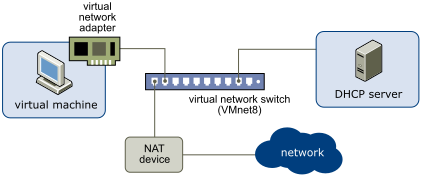When you install Workstation Player on a Windows or Linux host system, a NAT network (VMnet8) is set up for you. When you use the New Virtual Machine wizard to create a typical virtual machine, the wizard configures the virtual machine to use the default NAT network.
With NAT, a virtual machine does not have its own IP address on the external network. Instead, a separate private network is set up on the host system. In the default configuration, virtual machines get an address on this private network from the virtual DHCP server.

The virtual machine and the host system share a single network identity that is not visible on the external network. NAT works by translating the IP addresses of virtual machines in the private network to the IP address of the host system. When a virtual machine sends a request to access a network resource, it appears to the network resource as if the request is coming from the host system.
The host system has a virtual network adapter on the NAT network. This adapter enables the host system and virtual machines to communicate with each other. The NAT device passes network data between one or more virtual machines and the external network, identifies incoming data packets intended for each virtual machine, and sends them to the correct destination.